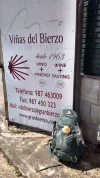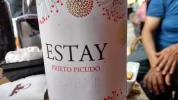I'm happy to share
@biarritzdon &
@JillGat : There are two that we have stayed at, both are just under an hour away from Santiago.
Lagar da Costa is good for exploring more touristy areas (Cambados and O Grove) and proximity to many other wineries, but
Entre Os Rios is a perfect tranquil nature escape with incredible hospitality. Both have great wine!
Enoturismo Lagar da Costa –A Casa Rural (Bed & Breakfast) in a typical Galician granite house with 7 guest rooms, a dining room / sitting room on the ground level, a beautiful yard with a pool, and the winery itself. It is nicely situated in the countryside between Cambados and O Grove with views of Isla Toxa, prefect for exploring the area (there are
a lot of wineries in this area). Their wine (mostly whites) is very highly regarded and the tour of the winery quite interesting (but was in Spanish). Our room was very comfortable and we enjoyed a plentiful breakfast down in the common area (also utilized through the day and evening as a sitting room with a refrigerator and with drinks available on the honor system). Their website is in English, but during our stay and winery tour they didn’t speak English. Weird side note: the neighboring house had THE BIGGEST CHICKENS I've ever seen in my life! I couldn't stop watching them from our window on the 2nd floor!
 Entre Os Rios
Entre Os Rios – Another beautiful Casa Rural also in a typical Galician granite house, this time with part of the main building actually an old mill built over one of the streams (one of the “rios” from the name which means “Between the Rivers”). They have 6 guest rooms, including one located in a cottage a bit away from the main house, a couple in the main house and a couple in the building next to the main building. This place is located up the hill and through the woods from a small port town, A Pobra do Caraminal. We traveled here as a family so we had two rooms. Teresa welcomed us warmly and treated us as if we were guests in her own home … well, we stayed in a room in the main house which actually IS her home. Breakfast there is incredible – in the warmer months it’s served out on the veranda but in the colder months (we visited in late April) in the old fashioned
lareira (a Galician kitchen with an open hearth). Teresa sets the fire and lays out plates of freshly sliced jamón (they have a leg in their kitchen), along with her homemade cake, jam and fresh squeezed fruit juice (lemon when we were there). Breakfast starts after 9:30 to allow her time to run down into town for hearty fresh bread from the bakery. One of their sons who lives nearby, José Crusat, is now the winemaker taking over for his father. In addition to Albariño, they are really proud to grow a little known Galician grape called “Raposo” (also grown near Betanzos on the Camino Inglés where it is known as “Branco Lexítimo”). José speaks nearly perfect English and loves showing guests around the vineyards and talking about the wine they produce … and he is VERY generous with samples of all of the wines and even his special batch of orujo. Their wines are extremely prized and produced in very small quantities. My favorites are the Vulpes Vulpes (100% Raposo) and KomoKabras (100% Albariño). The evening we did our wine visit, it ended up going kind of late so we drove down the hill into A Pobra to this local bar that makes the most amazing bocadillos con pulpo y queso San Simón (a Galician smoked cheese), called
Pulpería Bar Nuevo. We ordered sandwiches for everyone (the 4 of us in my family and José and his family) and enjoyed them in the comfortable family room of the main house with a bottle of the house wine. The Ruta del Río Pedrás hiking trail passes through the property (as does the Río Pedrás itself) and there are some interesting sights to see on this peninsula (called the Barbanza), such as the Dunes of Corrubedo, the Castro de Baroña, and many, many quiet beaches.
























